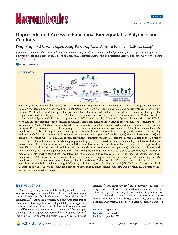摘要
The ever-growing biomedical technology such as tissue engineering, regenerative medicine, and controlled drug release intimately relies on the development of advanced functional biomaterials. Here, we report on versatile and robust synthesis of novel vinyl sulfone (VS)-functionalized biodegradable polymers that offer unprecedented access to advanced functional biodegradable polymers and coatings through selective Michael-type conjugate reaction with thiol-containing molecules. VS-functionalized biodegradable polymers including poly(e-caprolactone) (PCL), poly(L-lactide) (PLA), and poly(trimethylene carbonate) (PTMC) were conveniently prepared with controlled molecular weights and functionalities through ring-opening copolymerization of epsilon-caprolactone (e-CL), L-lactide (LA), or trimethylene carbonate (TMC) with a new cyclic carbonate monomer, vinyl sulfone carbonate (VSC), in toluene at 110 C using isopropanol as an initiator and stannous octoate as a catalyst. Interestingly, these VS-functionalized biodegradable polymers allowed quantitative modification, without aid of a catalyst, with various thiol-containing molecules including 2-mercaptoethanol, cystamine, cysteine, GRGDC peptide, and thiolated poly(ethylene glycol) (PEG-SH) at a ligand-SH/VS molar ratio of 2/1 in DMF at room temperature, confirming that the Michael-type conjugate addition to VS is highly selective and tolerant to most other functional groups including hydroxyl, carboxyl, and amine. Remarkably, results of contact angle measurements, X-ray photoelectron spectroscopy (XPS), and fluorescence studies showed that biodegradable coatings based on these VS-functionalized polymers allowed direct, efficient, and clean (without catalyst and byproduct) surface functionalization with thiol-containing molecules in aqueous conditions, which is unprecedented and opens a new avenue to surface functionalization of medical implants as well as cell and tissue scaffolds. The preliminary cell culture studies using MG6 cells showed that unmodified VS-functionalized PCL films, similar to tissue culture plate, could well support cell attachment and growth, indicating that VS-functionalized PCL film is nontoxic and biocompatible. The surface of VS-functionalized PCL films could be elegantly engineered with thiolated nonfouling polymers (e.g., PEG and glycol chitosan) or cell adhesive motif (GRGDC peptide) to control cell attachment and growth. We are convinced that these vinyl sulfone-functionalized biodegradable polymers have a tremendous potential in biomedical engineering.
- 出版日期2011-8-9
- 单位苏州大学
